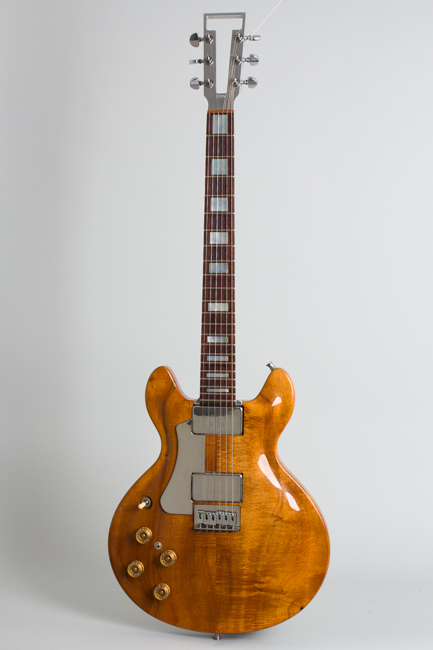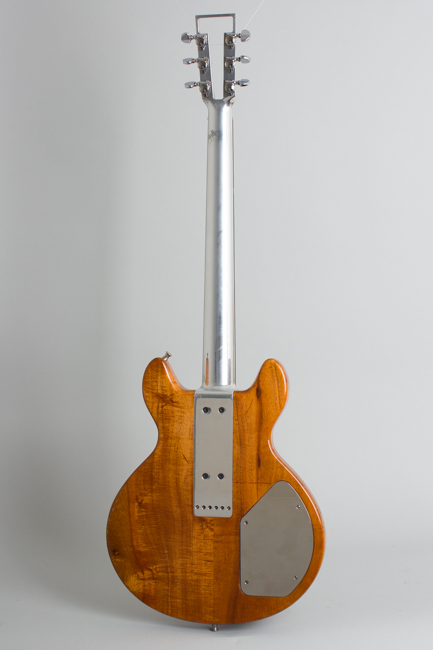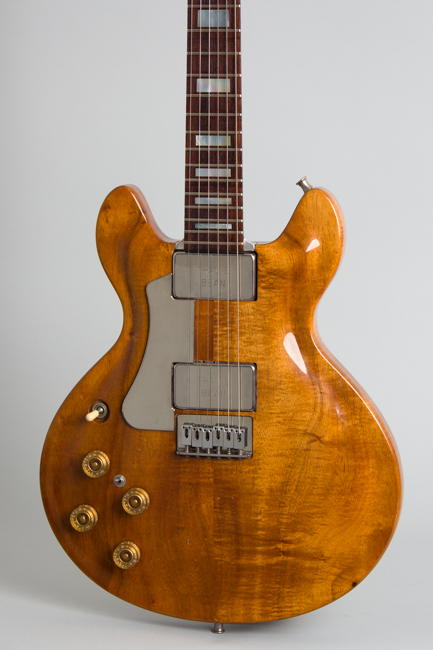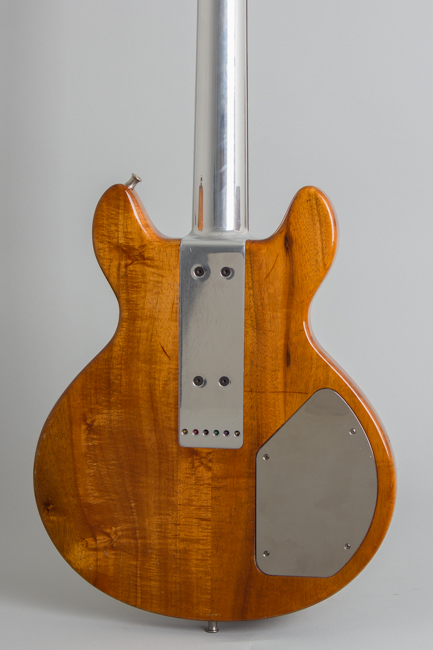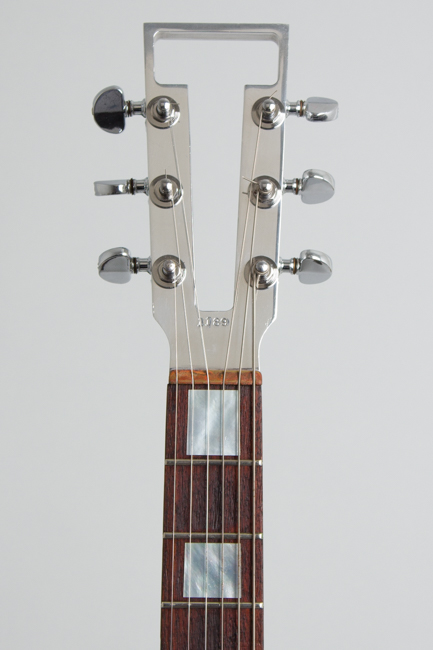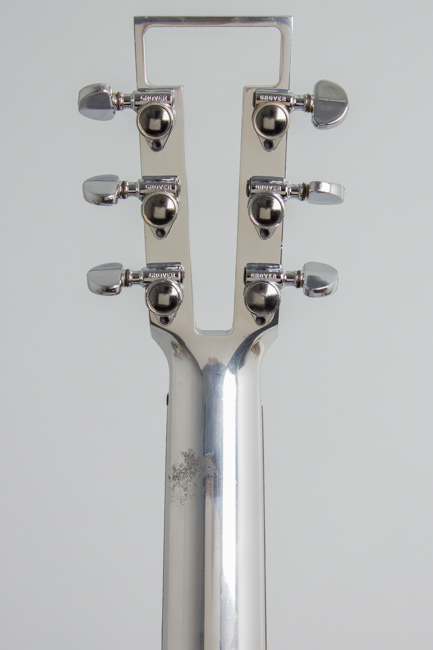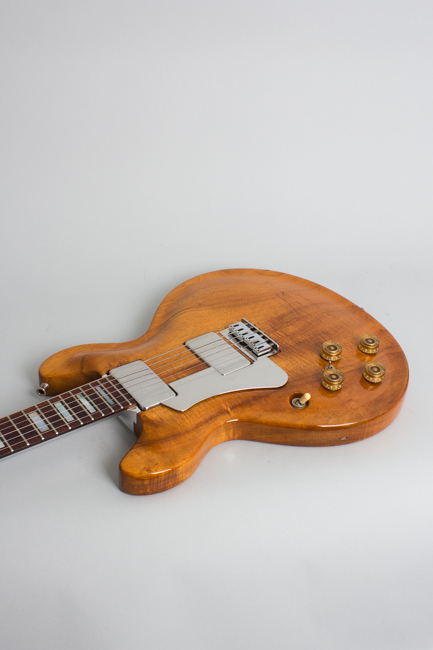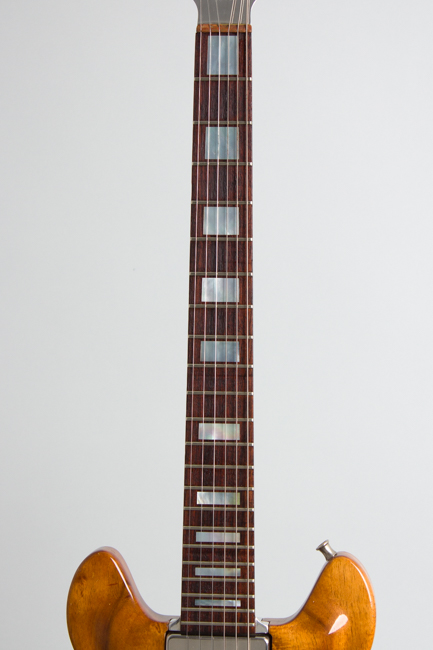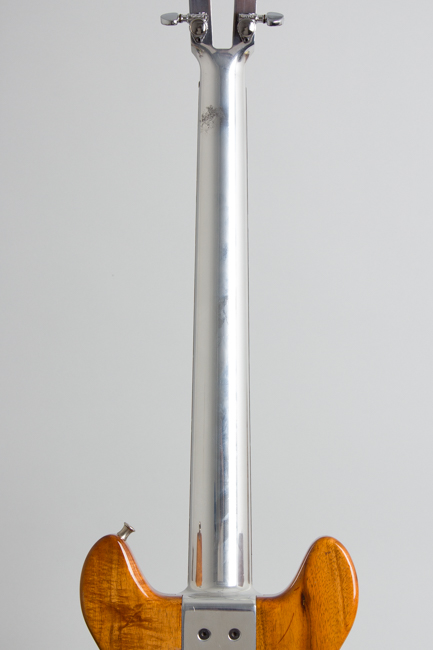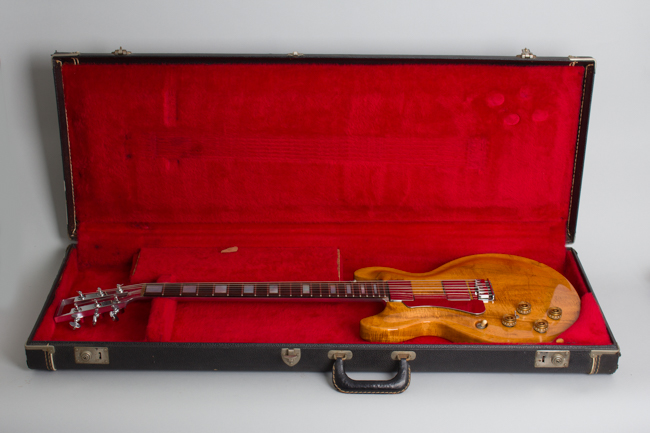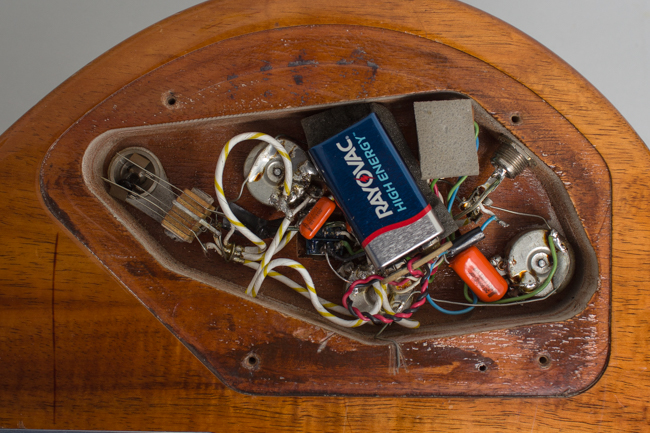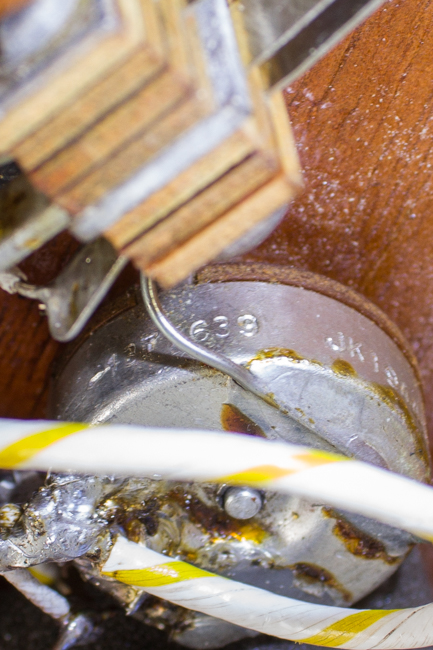Travis Bean TB-1000A Artist LEFT HANDED Solid Body Electric Guitar (1977)
Travis Bean TB-1000A Artist LEFT HANDED Model Solid Body Electric Guitar (1977), made in Sun Valley, CA, serial # 1189, natural lacquer body, natural aluminum neck finish, aluminum neck and centerpiece, koa body, rosewood fingerboard, original black tolex hard shell case.
This is a VERY rare factory left-handed Travis Bean TB1000A "Artist", the high-end model in the company's innovative but short-lived guitar line. It mates their patented raison d'etre aluminum neck/centerpiece with a carved solid Hawaiian koa wood body and ebony fingerboard with pearl block inlay. The company also offered the "Standard" TB1000S, similar but less deluxe, the budget TB-500 and the eccentrically shaped "Wedge" models. Of these the TB-1000A is the "classic" Bean, the most widely recognized and fondly remembered model. The number of "lefties" Bean produced is very small, estimated at perhaps only 10 or 20 over the entire run. This one has an interesting period electronics modification but remains an excellent player, and now effectively unique.
Former motocross racer and lifelong tinkerer Clifford Travis Bean had two partners initially; guitar tech Marc McElwee and Gary Kramer, who split off to found his own (for a time) successful guitar operation. Ads claimed their aluminum-necked designs were "the first new development in the electric guitar since the 1930s" although whether they were considering the early cast aluminum Rickenbacker steels is a moot point! The catalog continued "The...lightweight neck and receiver system forms a rigid link between the tuning machines and the bridge. When the strings are attached, a complete vibration connection is achieved. It is this patented chassis that makes the Travis Bean guitar what it is: an instrument that has become the most dramatic breakthrough in electric guitar technology in 50 years."
Bean's patented concept was a through-neck/central body core milled from T6061 aircraft aluminum, extending from headstock to the through-the-body strung six-saddle bridge. Narrow chambers running its length improved resonance and reduced weight, if only slightly. This metal centerpiece is mounted into a Hawaiian koa wood body finished in natural lacquer. All the higher end models mounted the company's own Alnico magnet humbucking pickups with "Travis Bean" engraved on their covers - the only branding on the instrument besides the subtle "T" cut out of the headstock! These in-house pickups have a stellar reputation on their own, but were never used on any other instruments.
This lefty Artist carries serial number #1189 stamped into the headstock which would indicate manufacture in later 1976 or 1977; the visible pot date is to the 39th week of 1976. The neck is a bit chunkier than earlier examples, with a comfortable round-backed profile. The sculpted Koa body has a beautiful grain pattern with some cross-grain patterns on the face and dramatic mineral spots on the back. The electronics have been altered to include a boost circuit that turns the already hot-sounding guitar into a real overdrive monster when engaged. The only visible sign is a small mini-switch added between the forward knobs.
The Artist model retailed originally for $1,395, making it one of the most expensive solidbody guitars of 1977. While not a huge commercial success they were featured by some major artists. Keith Richards, Ron Wood, and Bill Wyman all played them with the Rolling Stones in the mid '70s. Jerry Garcia played both a TB 1000 and a TB 500 for a time, so many deadheads revere them to this day. The guitars garnered a reputation for very high quality but many players felt the bare aluminum neck had a cold feel.
More recently, Travis Beans have been gainfully employed by a number of noise-rock players along with many denizens of myriad heavy sub-genres like doom and drone metal. The Bean sound is powerful and articulate at lover volumes, but winds up magnificently to a shuddering crunch when pushed in these heavy contexts. It has a lot of gain which makes it ideal for plugging in using a passive direct box straight into mic preamp input modules. Travis Bean knew he had something great in the mid-1970s; while his vision did not lead to major success at the time he would no doubt be well satisfied by the lasting appeal to players and highly collectible status his creations have earned nearly 50 years on. This southpaw "Beanie" is one of the rarest variations.
Overall length is 39 3/8 in. (100 cm.), 14 1/8 in. (35.9 cm.) wide at lower bout, and 1 3/8 in. (3.5 cm.) in depth, measured at side of rim. Scale length is 24 1/2 in. (622 mm.). Width of nut is 1 1/2 in. (38 mm.)., 11.34 lbs.
This Bean shows some general play wear overall but remains relatively clean overall and in excellent playing condition. There are numerous small nicks, scrapes and dings to the body finish with one deep ding on the top edge. The aluminum pickguard and the back of the neck extension show some scuffing from play. The back of the neck has only light marks except for one feelable corrosion mark at the lower end and still shines in its bare natural aluminum glory, and all hardware appears original except the added mini switch and the gold Gibson-style speed knobs; two incomplete sets of more correct black knobs are in the case.
The notable alteration to the guitar is to the electronics. The standard wiring circuit was altered within the first year or two of its life, fitted with a built in overdrive unit installed by the original owner. The electronics cavity was not routed larger than the cover, but a small rectangle was routed out to make room for this addition. This is activated by the mini-switch on the face and can be toggled off to return to the classic, high-output Travis Bean pickup sound. The tone knob for the bridge pickup has been adapted as a level control for this boost effect, leaving the neck pickup knob as a master tone. This circuit could be removed altogether if desired, but it does cement the 1970s vibe! The original pots and wiring are otherwise intact just as (probably) Obie soldered them. The screws securing the control cavity plate are not original (somebody lost them while doing the re-wiring, we'd bet!)
The rosewood fret board and original frets show only light wear, and the frets appear to have been recrowned in the past. This is a very nice, great playing and sounding Travis Bean, increasingly hard to find in the 21st century. This one of course has the particularly rare bonus of being one of the few factory lefties to ever see the light of day. It resides in what we can only imagine is the original case: a period correct case that looks slightly different from other Bean cases, but which appears to have been with the instrument its whole life (with vintage stickers included) and is partially molded to fit it perfectly. Overall Excellent - Condition.
This is a VERY rare factory left-handed Travis Bean TB1000A "Artist", the high-end model in the company's innovative but short-lived guitar line. It mates their patented raison d'etre aluminum neck/centerpiece with a carved solid Hawaiian koa wood body and ebony fingerboard with pearl block inlay. The company also offered the "Standard" TB1000S, similar but less deluxe, the budget TB-500 and the eccentrically shaped "Wedge" models. Of these the TB-1000A is the "classic" Bean, the most widely recognized and fondly remembered model. The number of "lefties" Bean produced is very small, estimated at perhaps only 10 or 20 over the entire run. This one has an interesting period electronics modification but remains an excellent player, and now effectively unique.
Former motocross racer and lifelong tinkerer Clifford Travis Bean had two partners initially; guitar tech Marc McElwee and Gary Kramer, who split off to found his own (for a time) successful guitar operation. Ads claimed their aluminum-necked designs were "the first new development in the electric guitar since the 1930s" although whether they were considering the early cast aluminum Rickenbacker steels is a moot point! The catalog continued "The...lightweight neck and receiver system forms a rigid link between the tuning machines and the bridge. When the strings are attached, a complete vibration connection is achieved. It is this patented chassis that makes the Travis Bean guitar what it is: an instrument that has become the most dramatic breakthrough in electric guitar technology in 50 years."
Bean's patented concept was a through-neck/central body core milled from T6061 aircraft aluminum, extending from headstock to the through-the-body strung six-saddle bridge. Narrow chambers running its length improved resonance and reduced weight, if only slightly. This metal centerpiece is mounted into a Hawaiian koa wood body finished in natural lacquer. All the higher end models mounted the company's own Alnico magnet humbucking pickups with "Travis Bean" engraved on their covers - the only branding on the instrument besides the subtle "T" cut out of the headstock! These in-house pickups have a stellar reputation on their own, but were never used on any other instruments.
This lefty Artist carries serial number #1189 stamped into the headstock which would indicate manufacture in later 1976 or 1977; the visible pot date is to the 39th week of 1976. The neck is a bit chunkier than earlier examples, with a comfortable round-backed profile. The sculpted Koa body has a beautiful grain pattern with some cross-grain patterns on the face and dramatic mineral spots on the back. The electronics have been altered to include a boost circuit that turns the already hot-sounding guitar into a real overdrive monster when engaged. The only visible sign is a small mini-switch added between the forward knobs.
The Artist model retailed originally for $1,395, making it one of the most expensive solidbody guitars of 1977. While not a huge commercial success they were featured by some major artists. Keith Richards, Ron Wood, and Bill Wyman all played them with the Rolling Stones in the mid '70s. Jerry Garcia played both a TB 1000 and a TB 500 for a time, so many deadheads revere them to this day. The guitars garnered a reputation for very high quality but many players felt the bare aluminum neck had a cold feel.
More recently, Travis Beans have been gainfully employed by a number of noise-rock players along with many denizens of myriad heavy sub-genres like doom and drone metal. The Bean sound is powerful and articulate at lover volumes, but winds up magnificently to a shuddering crunch when pushed in these heavy contexts. It has a lot of gain which makes it ideal for plugging in using a passive direct box straight into mic preamp input modules. Travis Bean knew he had something great in the mid-1970s; while his vision did not lead to major success at the time he would no doubt be well satisfied by the lasting appeal to players and highly collectible status his creations have earned nearly 50 years on. This southpaw "Beanie" is one of the rarest variations.
Overall length is 39 3/8 in. (100 cm.), 14 1/8 in. (35.9 cm.) wide at lower bout, and 1 3/8 in. (3.5 cm.) in depth, measured at side of rim. Scale length is 24 1/2 in. (622 mm.). Width of nut is 1 1/2 in. (38 mm.)., 11.34 lbs.
This Bean shows some general play wear overall but remains relatively clean overall and in excellent playing condition. There are numerous small nicks, scrapes and dings to the body finish with one deep ding on the top edge. The aluminum pickguard and the back of the neck extension show some scuffing from play. The back of the neck has only light marks except for one feelable corrosion mark at the lower end and still shines in its bare natural aluminum glory, and all hardware appears original except the added mini switch and the gold Gibson-style speed knobs; two incomplete sets of more correct black knobs are in the case.
The notable alteration to the guitar is to the electronics. The standard wiring circuit was altered within the first year or two of its life, fitted with a built in overdrive unit installed by the original owner. The electronics cavity was not routed larger than the cover, but a small rectangle was routed out to make room for this addition. This is activated by the mini-switch on the face and can be toggled off to return to the classic, high-output Travis Bean pickup sound. The tone knob for the bridge pickup has been adapted as a level control for this boost effect, leaving the neck pickup knob as a master tone. This circuit could be removed altogether if desired, but it does cement the 1970s vibe! The original pots and wiring are otherwise intact just as (probably) Obie soldered them. The screws securing the control cavity plate are not original (somebody lost them while doing the re-wiring, we'd bet!)
The rosewood fret board and original frets show only light wear, and the frets appear to have been recrowned in the past. This is a very nice, great playing and sounding Travis Bean, increasingly hard to find in the 21st century. This one of course has the particularly rare bonus of being one of the few factory lefties to ever see the light of day. It resides in what we can only imagine is the original case: a period correct case that looks slightly different from other Bean cases, but which appears to have been with the instrument its whole life (with vintage stickers included) and is partially molded to fit it perfectly. Overall Excellent - Condition.
